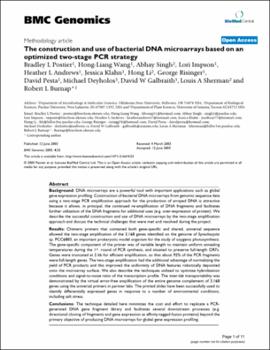| dc.contributor.author | Postier, Bradley L. | |
| dc.contributor.author | Wang, Hong-Liang | |
| dc.contributor.author | Singh, Abhay | |
| dc.contributor.author | Impson, Lori | |
| dc.contributor.author | Andrews, Heather L. | |
| dc.contributor.author | Klahn, Jessica | |
| dc.contributor.author | Li, Hong | |
| dc.contributor.author | Risinger, George | |
| dc.contributor.author | Pesta, David | |
| dc.contributor.author | Deyholos, Michael | |
| dc.contributor.author | Galbraith, David W. | |
| dc.contributor.author | Sherman, Louis A. | |
| dc.contributor.author | Burnap, Robert L. | |
| dc.date.accessioned | 2018-11-09T21:10:50Z | |
| dc.date.available | 2018-11-09T21:10:50Z | |
| dc.date.issued | 2003-06-12 | |
| dc.identifier | oksd_postier_theconstruction_2003 | |
| dc.identifier.citation | Postier, B. L., Wang, H.-L., Singh, A., Impson, L., Andrews, H. L., Klahn, J., ... Burnap, R. L. (2003). The construction and use of bacterial DNA microarrays based on an optimized two-stage PCR strategy. BMC Genomics, 4, Article 23. https://doi.org/10.1186/1471-2164-4-23 | |
| dc.identifier.uri | https://hdl.handle.net/11244/302063 | |
| dc.description.abstract | Background: DNA microarrays are a powerful tool with important applications such as global gene expression profiling. Construction of bacterial DNA microarrays from genomic sequence data using a two-stage PCR amplification approach for the production of arrayed DNA is attractive because it allows, in principal, the continued re-amplification of DNA fragments and facilitates further utilization of the DNA fragments for additional uses (e.g. over-expression of protein). We describe the successful construction and use of DNA microarrays by the two-stage amplification approach and discuss the technical challenges that were met and resolved during the project. | |
| dc.description.abstract | Results: Chimeric primers that contained both gene-specific and shared, universal sequence allowed the two-stage amplification of the 3,168 genes identified on the genome of Synechocystis sp. PCC6803, an important prokaryotic model organism for the study of oxygenic photosynthesis. The gene-specific component of the primer was of variable length to maintain uniform annealing temperatures during the 1st round of PCR synthesis, and situated to preserve full-length ORFs. Genes were truncated at 2 kb for efficient amplification, so that about 92% of the PCR fragments were full-length genes. The two-stage amplification had the additional advantage of normalizing the yield of PCR products and this improved the uniformity of DNA features robotically deposited onto the microarray surface. We also describe the techniques utilized to optimize hybridization conditions and signal-to-noise ratio of the transcription profile. The inter-lab transportability was demonstrated by the virtual error-free amplification of the entire genome complement of 3,168 genes using the universal primers in partner labs. The printed slides have been successfully used to identify differentially expressed genes in response to a number of environmental conditions, including salt stress. | |
| dc.description.abstract | Conclusions: The technique detailed here minimizes the cost and effort to replicate a PCR-generated DNA gene fragment library and facilitates several downstream processes (e.g. directional cloning of fragments and gene expression as affinity-tagged fusion proteins) beyond the primary objective of producing DNA microarrays for global gene expression profiling. | |
| dc.format | application/pdf | |
| dc.language | en_US | |
| dc.publisher | BioMed Central | |
| dc.rights | This material has been previously published. In the Oklahoma State University Library's institutional repository this version is made available through the open access principles and the terms of agreement/consent between the author(s) and the publisher. The permission policy on the use, reproduction or distribution of the material falls under fair use for educational, scholarship, and research purposes. Contact Digital Resources and Discovery Services at lib-dls@okstate.edu or 405-744-9161 for further information. | |
| dc.title | Construction and use of bacterial DNA microarrays based on an optimized two-stage PCR strategy | |
| osu.filename | oksd_postier_theconstruction_2003.pdf | |
| dc.description.peerreview | Peer reviewed | |
| dc.identifier.doi | 10.1186/1471-2164-4-23 | |
| dc.description.department | Microbiology and Molecular Genetics | |
| dc.type.genre | Article | |
| dc.type.material | Text | |
| dc.subject.keywords | synechocystis PCC6803 | |
| dc.subject.keywords | global gene expression profile | |
| dc.subject.keywords | printing condition | |
| dc.subject.keywords | universal sequence | |
| dc.subject.keywords | round amplification | |
